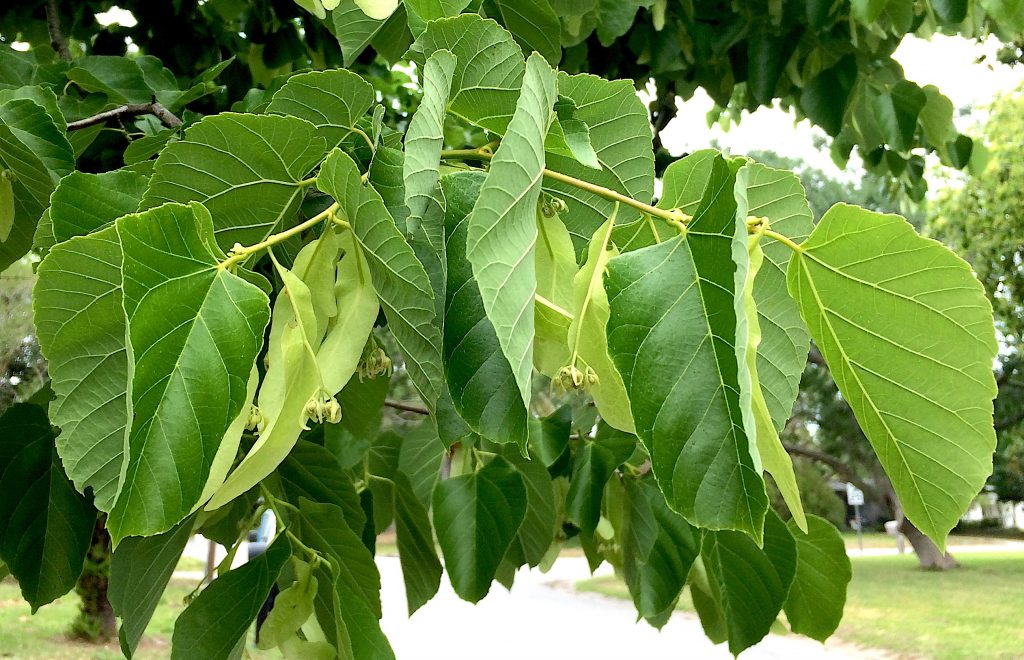
Basswood leaves and bracts, soon to be blossoming. Photo by Green Deane
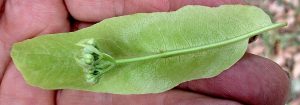
Bract and unopened blossoms of the basswood tree.
Basswood and I have been companions for some 60 years. A little over a mile from where I grew up my step-father’s brother-in-law owned several hundred acres of woods. Thus when a particular wood was needed for something we’d go there and wander around. There was hornbeam for tool handles and ash for whiffletrees. There were also occasional apple trees and a wide assortment of basswood. The latter two were used to make pipes. In those Maine woods the basswood grew not far above underground ledges. Locally I find them from damp spots to lawns. For most of the year basswood blends in well, a moderately sized tree with medium green leaves. Not distinctive. But, this time of year they are … outstanding! Basswood are the only tree in this part of the world with a single, large, lemon colored bract. And attached to that bract is a stem with blossoms on the end which will be edible seeds. The blossoms and young leaves are edible, too. You can read about basswood here.
During a private class this weekend we had the chance to see several Vacciniums in one place. One species was fruiting, another blossoming, and a third waiting for the right weather.
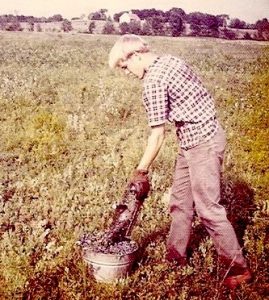
Harold Grandholm, a high school classmate, raking blueberries in a field off the road I grew up on circa 1969.
The blueberry is a crown berry. If you look at the end of the berry that’s farthest from the plant it has a little stylized crown with five points. Such berries can be bitter, woody, sour or sweet but not toxic. Identifying them can be a pain. Vacciniums are nearly as confusing as Hawthorns. Every blueberry species has been renamed at least once and there is no agreement on how many species there are in North America — 40? 65? — or what they look like. It depends on who is doing the writing, what criteria they use, and how good they observe. In New England where I grew up the small blueberries could cover 10 or 100 acres. Blueberry fields forever… In Florida they are sporadic — colonial — usually found near oaks and pines. Up north the fields were burned annually by machines designed to do just that. Near harvesting time another machine laid the field out in rows with string. One picker would work one row across the entire field. Harvesting blueberries with a “rake” was and is hard work, like digging up clams, bent over and back-breaking. The other kind of blueberry of my youth was high bush, eight to 12 feet high, usually on ledge. You had to compete with deer and bears. High bush blueberries can be so ladened you can come home with a washtub full of them. We also picked “clean” at my mother’s insistence. No leaves or bugs included.
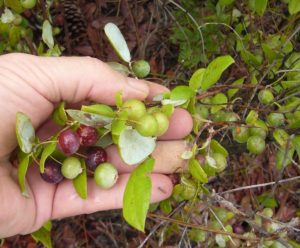
Deerberrries can be green or red when ripe. Photo by Green Deane
The flowering Vaccinium we saw this past weekend was Vaccinium stamineum. Deerberry is labeled “stamineum” because the male parts of the flower, the stamen, are very long. The fruit is also on long petioles, 3/4 to an inch long. (The stem between the fruit/blossom/leaf and the main stem is a petiole.) It likes scrub and hardwood that’s often wet and near water. Deerberry leaves are also white underneath. In fact ovalish leaves that are white underneath are the identifying characteristic of the species from other blueberries. And Deerberries when ripe are large and can be green to purple. As for other “blueberries” Vaccinium corymbosum, another blueberry I grew up with, is found in the northern part of the state essentially the width of the panhandle east to the Atlantic. Vaccinium corymbosum has warts on its stem — you will need a hand lens or more to see them — and hairs arranged in lines on the stems. Vaccinium arboreum (farkleberry) is a small tree. Vaccinium darrowii and Vaccinium myrsinites, are both around knee high and do look similar. Vaccinium myrsinites has little glands on stalks on the underside of the leaf (you will need #10 lens to see them) while the Vaccinium darrowii does not. Also the Vaccinium darrowii’s leaves, berries and flower stalks are usually covered with a powdery bloom that can be easily wiped off and the blossoms are redder near the tips.
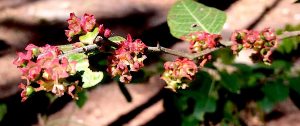
Huckleberries ripening. Photo by Green Deane
Huckleberries leaves have brilliant gold spots on the underside of the leaf. These are not ho-hum gold spots. They are vigorous, sparkling, in-your-eye spots shimmering like lighted jewels. They are best seen with a 10x magnifying glass. But, if the sun is out and you hold the leaf to the sun you can see with the unaided eye the brilliant spots. Also huckleberry fruit have exactly 10 seeds. While they may have some grit as well the number of seeds is constant and specific. Lastly note blueberries don’t have to be blue. They can be black. And huckleberries don’t have to be black, they can be blue. You can read about Blueberries here and huckleberries here.
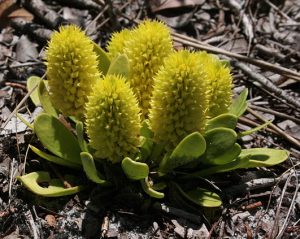
Candyroots vary in height. Photo by Green Deane
One gets used to seeing certain plants in certain places such as blueberries near oaks and pines. Dandelions also like acidic soil so they, too, can be found near oaks and pines. Lemon Bacopa (which tastes like lime) also seems to like specific places. I usually find it in the damp ruts of woods roads, or in damp spots on hiking trails, wet but sunny. Definitely not a suburban plant. I’ve actually found it in a body of water only once. Another site specific plant is Candyroot, pictured left. That, too, is often found along wood roads or paths that can be damp, either all the time or seasonally (that can be confusing. I have found Candyroot in wet places and places that are seasonally wet but mostly high and dry.) In its tiny root it there is some methyl salicylate, smells like mint, birch, or checkerberries depending on your nose. It is a mild pain reliever. You can read about Candyroot here.
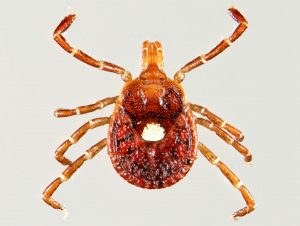
The female Lonestar Tick has a white spot, the slightly larger male does not.
Six and five years ago I found — despite careful checking — a deer tick attached. They can carry Lyme’s Disease so I went though the minor and inexpensive round of antibiotics each time. The disease is not common in Florida. Four years ago and this weekend it was a Lonestar Tick except it was attached four years ago. This weekend it was still looking for a good spot to drill in. The Lonestar Tick does not carry Lyme’s so that’s good. It does carry a lesser array of diseases but apparently they are all manageable to varying degrees. But it also has one liability: It can make you allergic to red meat forever. During the tick’s feeding it gives you a sugar, a long complex carbohydrate name shortened to Alpha-gal. This particular sugar stimulates your body to make an antibody. That sugar is found in red meat such as beef, lamb, pork, rabbit, goat, venison, and in cheese, butter, lard and gelatin. Thus when you eat any of those foods — or take medicine in capsules — you can have an allergic reaction which can include shock and death. The allergy can last for months, years, or life. Fortunately my one attached Lonestar tick did not give me the allergy but I have met several people with it. I think John Grisham is perhaps the most well-known person with the allergy. Current medical opinion is hat the tick has to stay attached for 24 hours to transfer the sugar. By the way, before Florida went on the internet it advised in several publications to use sublimed sulphur to keep ticks away. It’s inexpensive and you powder it on your cuffs and collars (if you are not allergic to it. I used it for several years with no problem then had an allergic reaction to it… a sneezing fit and eyes watering and itching so badly I couldn’t drive for about an hour.)
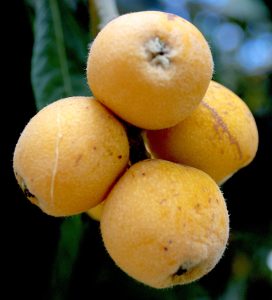
Loquats do not travel well. Photo by Green Deane
Loquats are ripening… They’re hard to miss: Small to huge tree with bright yellow to honey-colored fruit. Picked early they can be tart, picked late they will be not only sweet but aromatic like a cantaloupe. Sometimes they are incorrectly called Japanese Plums but they are not plums and are from China. It does not help that their botanical name means “wooly bunch of grapes from Japan.” They were growing in southern Japan when the Portuguese finally made contact with that nation. That’s probably why the name stuck. It’s also an evergreen tree and does well in landscaping. Even the leaves are used to treat lung issues such as coughing and wheezing. The fruit makes good wine, jelly, and with seeds removed dried like plums. Even the seeds have a few uses though I don’t endorse some of them. A couple of the more little-known facts about the species is that the fruit make a tiny amount of arsenic and the blossoms are pollenated by bees and houseflies. You can read about the loquat here.

Classes are held rain or shine or cold. Photo by Kelly Fagan.
Foraging Classes: Foraging classes this past week were both in the Jacksonville area. Although the Winged Yam won’t be sprouting for a few weeks we managed to dig one root up for the class to see. And the Paper Mulberries were starting to fruit but they won’t be ripe for a few weeks. We also saw a Firethorn heavy with blossoms. That means fruit in a few weeks, too. The Bottlebrush Tree was in full blossom. That class was followed by a look at a piece of property on the St. Johns River. One surprise was to find a persimmon in a small forest. They usually don’t grow there. The property also has many fruiting Vacciniums hence their mention above. We also saw a large amount of deadly Water Hemlock. perhaps spread by Hurricane Irma’s flood waters. And there was one mystery plant, which looked like a cross between a Dog Fennel and a Water Hemlock. I think it is something in the Ptilimnium genus, not edible. This week there is a class mid-state on the east coast in Melbourne and perhaps one in Gainesville. It’s Sunday on Easter and might not have many sign up.
Saturday, March 31st, Wickham Park, 2500 Parkway Drive, Melbourne, FL 32935-2335. Meet at the “dog park” inside the park, 9 a.m.
Sunday, April 1st, Boulware Springs Park, 3420 SE 15th St., Gainesville, FL 32641. Meet at the picnic tables next to the pump house, 9 a.m.
Saturday April 7th, Colby-Alderman Park: 1099 Massachusetts Street, Cassadaga. Fla. 9 a.m., meet near the restrooms.
Sunday April 8th, Eagle Park Lake, 1800 Keene Road, Largo, FL 33771. 9 a.m. Meet at the pavilion near the dog park
Saturday, April 14th, Blanchard Park, 10501 Jay Blanchard Trail, Orlando, FL 32817. 9 a.m. Meet at the pavilion east of the tennis courts near the YMCA.
Sunday, April 15th, Red Bug Slough Preserve, 5200 Beneva Road, Sarasota, FL, 34233, 9 a.m.
Saturday, April 22nd, Spruce Creek, 6250 Ridgewood Ave. Port Orange, 32127, 9 a.m., meet at the pavilion.
Saturday, May 5th, Florida State College, south campus, 11901 Beach Blvd., Jacksonville, 32246. 9 a.m. We will meet at building “D” next to the administration parking lot.
To read more about the classes or to pre-pay go here.

Green Deane DVD set of 135 videos
All of Green Deane’s videos available for free on You Tube. They do have ads on them so every time you watch a Green Deane video I get a quarter of one cent. Four views, one cent. Not exactly a large money-maker but it helps pays for this newsletter. If you want to see the videos without ads and some in slightly better quality you can order the DVD set. It is nine DVDs with 15 videos on each for a total of 135 videos. Many people want their own copy of the videos or they have a slow service and its easier to order then to watch them on-line. The DVDs make a good gift for that forager you know especially on long, cold winter months. Individual DVDs can also be ordered or you can pick and choose. You can order them by clicking on the button on the top right hand side of this page (if your window is open wide enough.) Or you can go here

Green Deane Forum
Want to identify a plant? Looking for a foraging reference? Do you have a UFO, an Unidentified Flowering Object you want identified? On the Green Deane Forum we chat about foraging all year. And it’s not just about warm-weather plants or just North American flora. Many nations around the world share common weeds so there’s a lot to talk about. There’s also more than weeds. The reference section has information for foraging around the world. There are also articles on food preservation, and forgotten skills from making bows to fermenting food. One special section is “From the Frightening Mail Bag” where we learn from people who eat first then ask questions later. Recent topics include: Bacopa monnieri, Herbalist Question, Bittercress?, Pine Pollen, Pawpaw? Thistle Flower Buds, Gigantic Pony Foot, Beach Carpet? Lots of Smilax and early Grapes Showing UP, Some Kind Of Pennywort, Plants Called Bugle, and Partridgeberry. You can join the forum by clicking on “forum” in the menu.
 Donations to upgrade EatTheWeeds.com and fund a book are going well and has made the half way mark, $5,500. Thank you to all who have contributed to either via the Go Fund Me link, the PayPal donation link or by writing to Green Deane POB 941793 Maitland FL, 32794. Recent upgrades have been paid now the Forum needs work and several function problems need to be fixed specifically the search and categories ( a partial solution is that when you do a search other finds are directly below the main one shown. Scroll down.) A new server also has to be found by April. The other issue is finding an indexing program or function for a real book. Writing programs used to do it automatically if you designated a term for indexing. Now that most books are ebooks most writing programs do not provide and indexing function. The hunt continues.
Donations to upgrade EatTheWeeds.com and fund a book are going well and has made the half way mark, $5,500. Thank you to all who have contributed to either via the Go Fund Me link, the PayPal donation link or by writing to Green Deane POB 941793 Maitland FL, 32794. Recent upgrades have been paid now the Forum needs work and several function problems need to be fixed specifically the search and categories ( a partial solution is that when you do a search other finds are directly below the main one shown. Scroll down.) A new server also has to be found by April. The other issue is finding an indexing program or function for a real book. Writing programs used to do it automatically if you designated a term for indexing. Now that most books are ebooks most writing programs do not provide and indexing function. The hunt continues.
This is weekly issue 297. There have been several suggestions that the newsletter font is difficult to read. We are working on that this week.
If you would like to donate to Eat The Weeds please click here.


I prefer an electric guitar constructed of basswood for the (solid) body. Just refer the way it sounds
and as I have been playing since 1963, I’ve had a listen to most.
BTW Eddie Van Halen also uses basswood and nothing else so I’m not alone with my reference, ‘course he’s a little more famous the I am…
Plugging away in the Crescent City…N’Awlins.
Jimmy Roy
Thank you Deane for naming the plants you saw in the foraging classes, with associated links. It really helps me ID things I see around at the same time the newsletter comes out! Hope I get to a class soon.